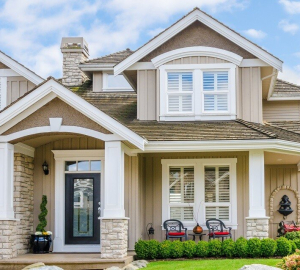Something that all homeowners have to contend with is property maintenance. Keeping up with general repairs, and occasional renovations, helps properties to maintain their value. Indeed, a well-kept home should grow in value over the years.
A major part of any building’s structure is the roof. Roofing helps protect a home’s structure and keeps the house together. Your roof provides shelter, warmth, and protection. Your home simply wouldn’t function without proper roofing.

Unfortunately, roofs have a lifespan. When that comes to an end, a replacement will be needed.
The signs that show your roof is in need of replacing
Very often, problems with roofs require fairly simple repairs. Shingles may get lost in storms. And flashing may become loose. When these things occur, leaks may happen as the roof is no longer fully protected.
However, over time, the elements will take a toll on a roof to the point where it needs more than just repair work. Arrowhead Roofing was asked what the common signs are when a roof needs replacing.
The professionals there listed the following:
- Sagging roof
- Age of the roof
- Leaks
- Damaged shingles
- Structural weakness eg, rot
- Mold and mildew
- Granule loss
- Poor energy efficiency
It may be that you are unaware of how old your roof actually is. One major sign that age is catching up to your roof is when your neighbors start to replace theirs. Residential areas often have groups of homes built at the same time. Therefore, the roofs will have similar lifespans and need replacing around each other.
Leaking roofs will lead to moisture in the attic. This causes mold, mildew, and rot. Left unattended, the structure of a roof will be weakened when exposed to the elements. Rotting roofs lead to serious structural damage and present a danger to the occupants of the home.
The importance of replacing your roof professionally
There are certain upgrades to increase energy efficiency in a home. About a quarter of a home’s heat is lost through the roof. The right roofing materials will make your home more economical to run. However, if roof replacement is not done correctly, it could lead to further problems.
Millions of people love nothing more than to take on DIY projects. In most cases, the worst that can happen is a bodged job that is less than pleasing to the eye. With roofing though, DIY work can be dangerous if you aren’t equipped for the job.
Reasons to use professional roofers include:
- Lack of expertise
- Warranties
- Safety issues
- Time to complete the project
- Equipment
DIY gives the opportunity to save cash. Yet, some projects end up costing more when professional help is ignored.
Lack of expertise
Equipment can be included in this section also. A lack of proper tools and knowledge will lead to a poor roofing job. Roof replacement is a skilled job carried out by trained professionals. Proper inspections need to be carried out, and the right materials selected. Most DIY enthusiasts will lack the knowledge to tackle a full roof replacement project.
Lack of warranties
A new roof will have a warranty. The roofing company that installs the replacement will also have insurance and other guarantees for their customers. A DIY roofing job will miss out on a number of these benefits.
There are a number of ways to increase the value of a home. New roofs certainly add value. But, one without a proper warranty may put off buyers rather than push your home’s value up.
Safety issues
Roofing is a dangerous job. One study placed roofing at number six on a list of risky jobs. Unskilled individuals are even more likely to have an accident than trained roofers.
The time taken to install a new roof
Experienced roofers will install a new roof far quicker than unskilled DIY enthusiasts. A professional roofing firm will be able to provide a quote and a turnaround time.
Factors to be considered before replacing a roof
The main factor will be picking the right roofing company. The usual route for this will be word-of-mouth and some simple online research. Checking out reviews often helps. As does asking roofing companies direct questions about their experience.
Consumer websites can help when weighing up which company to select. You may also like to see if the roofing business has any affiliations. The National Roofing Contractors Association provides certification for reputable roofing companies.
Gathering quotes from different roofers will help to establish the costs involved. This will help you budget. There are other considerations such as what materials will be used and warranty lengths.
You should weigh up the costs of certain materials against the value they offer. It may be worth spending more for a roof that will last significantly longer than a cheaper alternative.
Factors involved in selecting roofing materials
When looking into choosing your new roof’s materials, consult with your chosen roofer. Their advice will be invaluable at this point. But, for your consideration, there are factors involved in selecting the best roofing materials.
Consider the following when selecting roofing materials:
- Your budget
- Lifespan and durability
- Local climate
- Energy efficiency
- Sustainability
- Aesthetics
You may have to consider building construction codes too. There may be restrictions surrounding energy efficiency or fire resistance. Your roofer should be aware of any restrictions on materials.
The climate is important too. The Solar Reflectance Index is used to gauge how effective a roof might be for cooling a home. Some materials help to cool homes down, and lower energy costs. Other materials may be more beneficial in areas that regularly experience high winds and storms.
What is the process involved in a roof replacement?
There are several steps to roof replacement. Initially, an inspection and assessment need to be carried out. Only once it has been determined that a replacement roof is necessary will the roofer move on to the next steps.
Material selection
Once you have accepted a quote. The materials will then be selected. As mentioned previously, several factors are at play here, not least your budget.
Roof removal
Specialist equipment will be used to make short work of removing shingles. Layer by layer, your existing roof will be removed. This will include any rotten wood or damaged parts of the structure.
Preparation and repair
Any necessary repairs to the roofing deck will be carried out now to provide a solid foundation for the new roof.
Installation of underlayment and roofing materials
Asphalt felt or similar will be laid on the deck. This helps to protect against moisture. After the felt is installed, shingles or other roofing materials will follow.
Ventilation and flashing
Flashing is used around areas where water can penetrate. Vents, chimneys, and skylights will need flashing. Also, ventilation is needed at this point to provide airflow through the attic. Proper airflow helps to stop moisture from building up.
Final inspection
The roofing firm must carry out a final inspection now. And a thorough cleanup should also be done to remove debris.
Summary
It is critical to use a professional roofing company unless you have previous experience in this area. Roofers will be able to advise on the best materials to use for energy efficiency and durability. Your budget will impact what roofing materials you can use/ But, roofers’ expertise means you will be advised on the best options for your budget.
Proper roof replacement is a guaranteed way to add value to your home. And to protect it for years to come. Cut corners though, and you may face more roofing problems sooner than expected.



